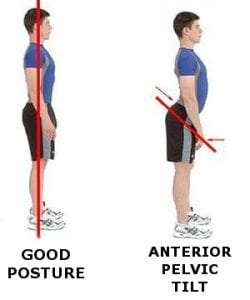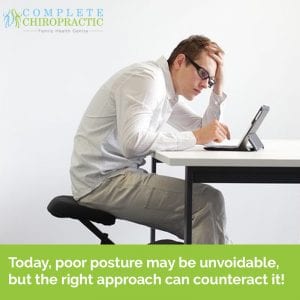Poor posture is one of those issues which we often dismiss in our everyday lives – everyone has poor posture today right? Sadly you’re not far wrong, with almost all of us now spending some time in front of a computer or working at a desk, poor posture has become a modern-day epidemic! This week, let’s look at some of the most common postural issues out there, and, more importantly how we can fix them.
Avoiding poor posture..?
It goes without saying that the best way to treat poor posture is to avoid developing it in the first place. For many years, chiropractors have recommended that you limit your time in front of a screen or at a desk – but in today’s world is this advise still practical? Some of us can reduce our “screen time” at home and in our free time, but these days it’s a rare job which doesn’t involve some time hunched over at a desk. With this in mind, it may now be more practical to think about ways to combat poor posture rather than simply giving the advice to avoid it in the first place. The good news is that appropriate chiropractic care and targeted exercises can effectively counteract poor posture.
Number 1 – “The Hunchback”
Ideally, your head should sit in alignment with your hips when viewed from the side, and while the spine does have natural curves which are important for balance, there shouldn’t be a noticeable “hunching” in your posture. In individuals with a “hunchback”, the spine forms a “c” shape, and the head usually extends forwards, rather than being in correct alignment.
The Cause: The hunchback is simply the consequence of sitting for long hours with a head down and forward posture – simply put, the head weighs a lot, and having it constantly forward and out of balance puts a surprising amount of stress on the spine, slowly dragging it down .
The Symptoms: A hunchback posture throws your entire upper body out of alignment, and typically causes pain in the neck, shoulder, and back. This constrictive posture causes the chest muscles to tighten, further contributing to an excessively curved spine in the upper back or thoracic region. The muscles of the upper back do the opposite – and eventually, weaken.
Treatment: “Standard” chiropractic treatment is an excellent approach for getting the spine moving again and for freeing up the entire upper back. Thereafter, advanced chiropractic care using the Chiropractic Biophysics “mirror image” technique is highly effective in correcting any muscle imbalances which have developed – over time, this will restore normal posture.
At home, exercises such as the “prone cobra” can help to combat the development of a hunchback posture Lie with your face down, arms at the sides, and palms down. Slowly lift your chest and hands off the floor, and press your shoulder blades together, keeping your chin down. Hold this position for five seconds. Do this ten times.
Number 2 – the “Forward Head”
The forward head posture typically accompanies a hunchback posture and has essentially the same cause.
The Cause: Forward head posture is especially strongly linked to the use of mobile devices, and is one of the main symptoms of what is now known as “text neck”
The Symptoms: The main symptom of forward head posture is typically neck pain – although left untreated the condition will tend to develop into a full-blown hunchback posture. Forward head posture itself leads to tightness of the muscles of the back of the neck, along with the muscles of the upper back – while these are painful conditions in and of themselves, they can also serve as contributing factors in the development of headaches or migraines.
Treatment: When dealing with a forward head posture, it’s important to get a thorough assessment of the spine as a whole in order to determine the extent to which your posture has deteriorated. There is little value in treating just a neck issue if misalignments exist further down the spine. A chiropractic evaluation is ideal for this, after which a combination of adjustments and targeted exercises can be used to quickly correct the issue. Since many of us just can’t manage to live without checking our devices every five minutes, regular chiropractic maintenance care can be a good way to counteract the “head down” posture that this causes.
As a preventative measure, try to strengthen the muscles in the back of your neck. Lie on the floor, face-up, and lift your head up from the floor. Hold this position for five seconds and repeat ten times. Be very careful with exercises which target the neck, however, as it is easily injured. Seek professional advice if unsure.
Number 3 – Rounded Shoulders
The Cause: Rounded shoulders, or shoulders which appear to be rotated forward (rather than in line with the body) are also caused by poor desk posture but are also often a consequence of uneven training at the gym or a result of the specific demands of your chosen sport or outdoor activity.
The Symptoms: Rounded shoulders can cause pain in the neck, shoulders and back but are also one of the most frequently cited visual issues which clients wish to correct. Rounder shoulders can make your chest appear smaller and diminish the “V” shaped proportions which many people train to enhance.
Treatment: The best treatment for rounded shoulders will depend on the cause – where the condition is related to time spent at a desk, the same approach as above will be effective. For individuals who suspect that uneven training, injury, or just the demands of their sport may be implicated, sports therapy may be a more appropriate methodology to tackle the problem. Our sports therapists are trained not only to correct these issues but also to work on preventing them from occurring again. If injury was also a factor in your condition, then sports therapy combined with approaches such as sports massage, can improve healing time considerably.
At home, it is worth trying to set aside some time to stretch tight chest muscles. Place your arm against the wall on the side of a doorway in a high-five position, with your elbow bent 90 degrees. Take a step through the doorway and you will feel a stretch in your chest and the front of your shoulders. Hold this position for 30 seconds. Repeat 2 to 3 sets of this, four times daily.
Number 4 – Over-Pronated Feet
Problems with the feet are frequently overlooked, but in fact, many issues which manifest in foot position have a root elsewhere in the body. Any issue which fundamentally affects your stability and balance makes you more accident prone so shouldn’t be ignored! In over-pronation, the arches of your feet are flat or too flat, causing your ankles to bend slightly inwards or outwards depending on your stance.
The Cause: Over-pronation can have a wide variety of causes, and is best assessed by a trained sports therapist. Some causes are easy to identify and fix relatively quickly – Pregnancy is a common cause as is poor shoe selection. Obesity, injury or some knee issues can also play a part.
The Symptoms: Overpronation adds pressure on the foot, tightens the calf muscles, and may rotate the knees towards each other. It can result in a range of painful conditions in the foot itself, may encourage the development of bone spurs in the heel and can often translate to back or hip pain.
Treatment: The solution to overpronated feet depends on the cause – longer term issues as obesity can be reduced using a targeted plan, whereas support for medium-term causes such as pregnancy can be given, and the condition often resolved after birth. Overpronation can also often be treated very quickly – if poor shoe choice is the issue, a change is often enough to make a real difference. In some cases, specialist orthotics can be used inside your shoes to correct the issue. If it is safe to do so walking or running barefoot may also help in strengthening the arches.
Number 5 : Anterior Pelvic Tilt 
Anterior Pelvic Tilt is a common condition where a person’s pelvis tilts forward, pushing his/her torso forward, bending the back and reducing spinal alignment.
The Cause: Anterior Pelvic Tilt is very common in those who are involved in resistance training, but is an issue which affects many of us. The fundamental issue is extended periods of sitting without stretching, this tightens the hip flexors and negatively affects pelvic alignment.
The Symptoms: Anterior Pelvic Tilt may cause pain in the lower back and often creates the impression of having a protruding stomach, although you may not actually have any stomach fat.
Treatment: In general, you should stretch before each workout and at least once a day even if you are not partaking in exercise. Anterior Pelvic Tilt is a common issue which sports therapists can correct rapidly through targeted exercise. At home be sure to perform stretches which target the hip flexors.
Try kneeling on one knee and tightening your gluteal muscles (muscles in the buttocks) on the leg you are kneeling on. You will feel a stretch in the front part of your hip. Raise the arm on the same kneeling side and stretch towards the opposite direction. Hold this position for 30 seconds, relax, and repeat again 4 times.


